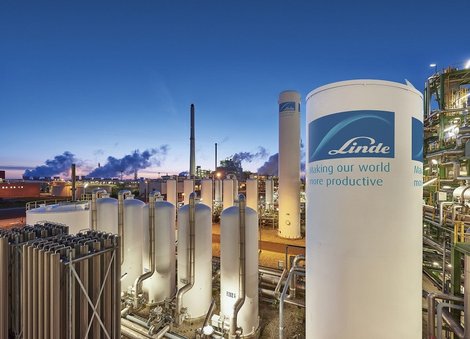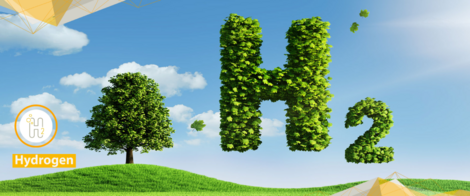With 24 megawatts capacity, the world's largest hydrogen liquefier
Linde puts the emphasis on green liquid hydrogen production in Leuna

The gas and engineering company Linde is doubling its capacity for producing liquid hydrogen at the Chemical Park Leuna in the south of Saxony-Anhalt. The new liquefaction plant, which will come into operation during the coming year, fits seamlessly into the state’s hydrogen strategy.
Saxony-Anhalt is looking to the future and compensating for the phase-out of coal by transforming itself into a model region for hydrogen. “This offers considerable potential for Saxony-Anhalt because it will encourage more companies to move here and create high-quality jobs along the hydrogen value chain,” says Minister for the Economy Armin Willingmann, emphasizing the importance of the second hydrogen liquefaction plant being constructed by Linde in the Chemical Park Leuna.
Linde is currently one of the largest hydrogen producers in the world and the company’s project is correspondingly ambitious. It is adding a new facility of the same size to its existing liquefaction plant, which was constructed in 2007. Both plants will be able to produce 230 kilograms of liquid hydrogen per hour. To supplement the existing steam reformer that runs on natural gas, Linde is also constructing a modern PEM (proton exchange membrane) electrolysis unit on the site. The new electrolyzer has a capacity of 24 megawatts, which will make it the largest in the world to use this specialized technology to split water into oxygen and hydrogen.
The new plant will initially be run in trial mode and then in the fall will go into continuous operation. It will liquefy hydrogen at a temperature of 253 degrees Celsius and this will then be loaded into trucks at special filling stations. By the end of 2022, the company aims to be producing 3,200 tonnes of hydrogen per year. The full annual capacity is 4,200 tonnes. “The liquefier reduces transport costs, because a tanker can transport ten times as much liquid hydrogen as gas. This helps customers to reduce their greenhouse gas emissions without having to make changes to their own production facilities,” says Andreas Dietrich, on-site account manager at Linde. In addition, the liquefaction process improves the purity of the product, which is particularly important for the manufacture of electronic components.
Key element of the energy transition
The new plant has cost the company a total of around 60 million euros, including a subsidy of 15 million euros from the state government of Saxony-Anhalt and the German federal government as part of the Joint Task for the Improvement of Regional Economic Structures. Linde explains its commitment in terms of the increased demand for green hydrogen. This is in part the result of the National Hydrogen Strategy, which regards hydrogen as a key element in the energy transition. Other factors that contributed to the decision on the new plant, in addition to Linde’s existing production portfolio of industrial gases, were the extensive pipeline network and the excellent infrastructure connections. Also, the liquid nitrogen needed for the preliminary cooling process is produced cost-effectively on the site.
Initially, Linde will use certified green electricity to produce the hydrogen, but ultimately the process will be powered entirely by renewable energy from the region. “We are currently looking for suitable sites near the Chemical Park Leuna where we can build new solar and wind farms to supply the plant with renewably generated electricity from 2022,” explains Dietrich.
Because of its existing energy infrastructure, which includes the pipeline network, the storage caverns and the facilities for generating renewable energy, Saxony-Anhalt is in an excellent position to become a forward-looking, zero-carbon model region for hydrogen where green hydrogen can be produced, distributed, stored and used quickly and locally. The synergies can easily be exploited. For example, Linde is cooperating with HYPOS, the German national hydrogen network, at the Fraunhofer Institute for Microstructure of Materials IMWS in Halle (Saale). In addition, in close collaboration with representatives of the state governments of Saxony-Anhalt and Saxony and with companies in the region, Linde is investigating the possibility of expanding the hydrogen network around the chemical park, in particular in the direction of Leipzig Nord and the caverns in Bad Lauchstädt.
Eight-point plan
Linde’s commitment to the new plant fits perfectly into the new hydrogen strategy recently adopted by the state of Saxony-Anhalt with the aim of creating a framework for a green hydrogen economy in this industrial and energy region. The state government has agreed on an eight-point plan for the coming years which highlights the state’s main priorities in this area. Goals for the hydrogen economy have been formulated for the periods up to 2030 and up to 2040. The strategy has been produced on the basis of close cooperation between the Ministry of Environment, Agriculture and Energy, the Ministry of Economy, Science and Digitalization and the Ministry of Regional Development and Transport.
Author: Anja Falgowski/IMG Saxony-Anhalt

Saxony-Anhalt offers good starting conditions for the development of a forward-looking hydrogen economy.
As a traditional chemical site, the state has many years of experience with hydrogen utilization in the Central German Chemical Triangle.
